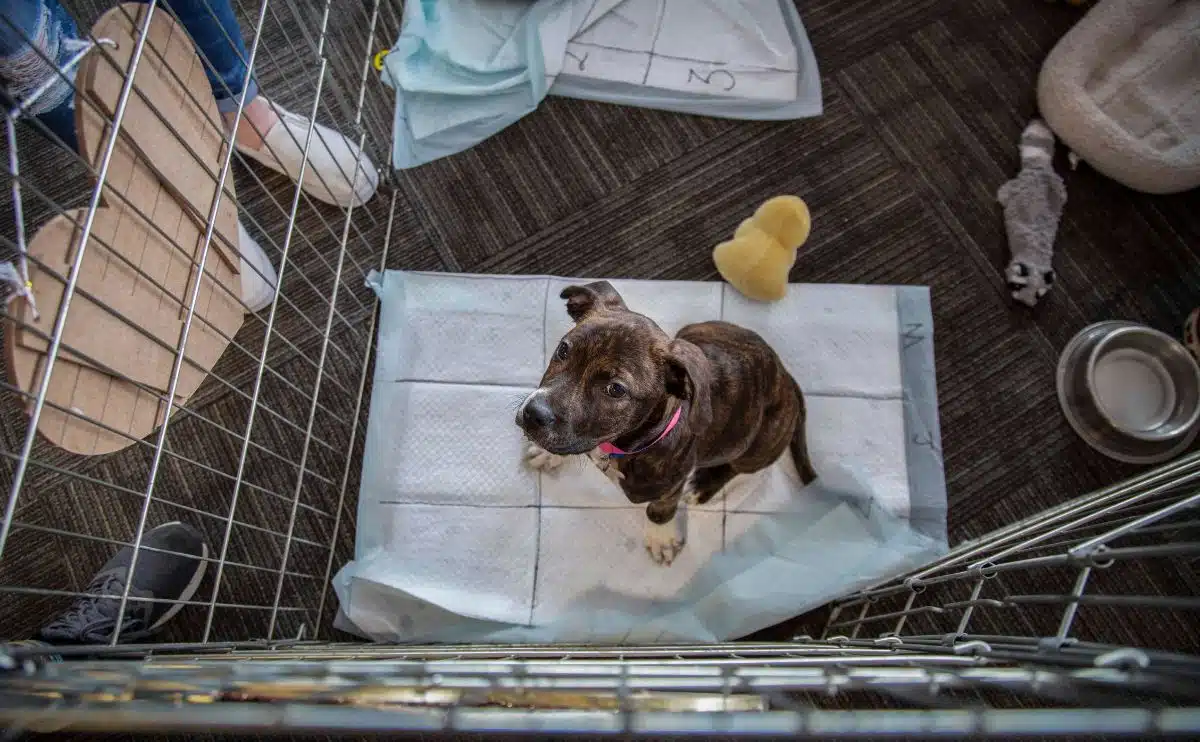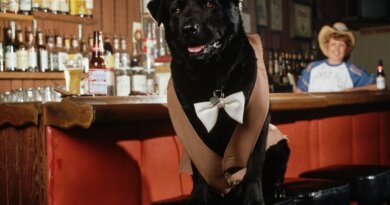How Long Can Dogs Hold Their Pee?
To keep the lights on, we receive affiliate commissions via some of our links. Our review process.

Dogs regularly need to go out to use the bathroom, but how long can they hold their pee? Is it harmful to make a canine hold its bladder? How often does a dog need to urinate on a typical day? Dog owners need to know this information, especially if they must leave their pet at home all day without going outside to urinate. This topic is much bigger than simply taking your pup out every few hours. There is a lot that owners must know about how long dogs can hold pee.
How Long Can A Dog Go Without Peeing?
All dogs are different, and some may be able to go longer than others without relieving themselves. However, a general guideline is that adult canines between one and seven years old can hold their urine for between six and eight hours. Of course, several factors impact this. A dog’s age, health, size, diet, sex, and activity level all impact the amount of time they can go without urinating.
It is important to note that puppies cannot hold pee as long as adults. Seniors, those aged seven years and older, may only be able to hold their urine between two and four hours. Some young canines may be able to hold their pee for eight to 10 hours, but this does not mean they should do it every day. This is also uncomfortable and puts extra strain on their urinary system.
Holding their urine in for too long can lead to physical discomfort, bladder and urinary tract infections, crystals, and stones. Ideally, dogs should not go more than six hours without an opportunity to relieve themselves.
In addition to causing physical distress, and impacting the function of the canine urinary system, holding it in can lead to behavioral concerns. Pups can become stressed, irritated, frantic, and anxious. They will start to whine, bark, and may even begin to chew or try to paw their way outside.
How Often Do Dogs Need To Pee?
How often dogs must pee depends on a few things, including age. Younger animals go more often, as do seniors. Generally, pups over one year to seven years old should go out once every six hours.
Some general guidelines (for adult canines) to relieve themselves are below:
- Age one year to seven years – every 6 to 8 hours.
- Eight years to ten years every 4 to 6 hours.
- Seniors over ten years old must relieve themselves every 2 to 4 hours.
- Expect to let your pup out between 4 and 8 times a day on average.
How Long Can A Dog Hold Its Bladder?
The amount of time a dog can control their bladder will depend on the specific animal, but owners can follow some general guidelines. Age has a significant impact. Younger adult canines can hold urine for between 10 and 12 hours if necessary.
Males urinate more often than females. Females are generally able to control bladders longer than males.
Smaller pups have smaller bladders, which means they cannot keep in their urine as long as larger pups. Canines do not all make the same amount of urine. Larger animals make more urine but also have larger bladders in comparison to their size and weight. Adult pups in a normal environment with no extenuating circumstances produce between 10 and 20 ml of urine per pound of body weight over a 24-hour span.
How Does Size Impact Urine Holding?
- Dogs that weigh less than 10 pounds can only control bladders for one to three hours.
- Medium-sized dogs reaching about 30 pounds can control urine for 2 to 4 hours.
- Larger animals between 40 and 60 pounds can go between 4 and 8 hours.
- Big breeds over 60 pounds can control their bladder on average between 6 and 12.
These estimates pertain to healthy adults between the ages of 1 and 7 years.
How Long Can A Dog Hold Its Bladder Overnight?
The answer to this question is about 6 to 8 hours on average. Some pups may be able to last 10 hours, while others may only make it to five. Letting your pups out directly before laying down for the night and not allowing them to have too much water right before bed can help extend the amount of time they can comfortably control their bladders while asleep.
Puppies and senior pets will not control things as well overnight. As a canine enters their senior years, around age seven, they will begin to have less control of their bladder over time, even when asleep.
How Long Can Puppies Hold Their Pee?
Puppies have much less capacity to control the bladder than adult canines. Young puppies have no ability to control this. As they age, they increase the length of time they can go between potty breaks. In general, expect a puppy to be able to hold pee for an hour per month of age once they have been house-trained. This is a general guideline, not a hard and fast rule. Puppies tend to drink and eat a lot more, so they feel the urge to go much more often.
Puppy Bladder Control Chart
| Puppy Age | How Often They Need To Pee |
|---|---|
| Under one month | No bladder control |
| Under 3 months (assumes housebroken) | As needed, take out once an hour at least |
| 3 to 6 months | Once an hour |
| 6 months | Once every 1 to 2 hours |
| 6 -9 months | Every 2 to 4 hours |
| 9-12 months | Every 3 to 6 hours |
| 1 year | Every 6 to 8 hours |
Factors That Impact The Time A Dog Can Hold Their Bladder
Along with age and size, a few other factors impact a canine’s ability to control their bladder. These include diet, health or behavioral issues, environment, and activity.
Diet & Water Intake
How much a dog eats and drinks, as well as what they are eating, impacts how often they have to pee. On days when dogs drink a lot due to heat or exertion, like a brisk walk, they often urinate more. Diets high in salt and fat make canines want to drink more, which means more potty breaks.
Kibble has much less moisture content than wet and fresh food. Canines that eat kibble primarily urinate less than those eating wet, canned, fresh, and raw diets. Owners must ensure canines have enough moisture in their systems. If your pet eats kibble primarily, make sure to offer plenty of fresh, clean water, as well as consider adding wet dog food, low-sodium broth, dog gravy, and other sources of extra moisture into their diets.
Health Issues
Many dogs suffer from health issues and ailments that affect how well they can control their bladder and how often they have to pee. A veterinarian should examine pets who suddenly begin urinating more often or at a higher volume to ensure they are not suffering from any kind of kidney, urinary tract, or other health issues. Always contact your vet if your pup is peeing blood.
Conditions That Cause Increased Urination
Environment
Dogs can be very sensitive when it comes to relieving themselves. They may refuse to go if they are in a new place or feel uncomfortable. This can even happen in a familiar environment when they feel something is off. This goes both ways, and some canines may feel the urge to urinate more when they feel scared, anxious, or excited. This can happen when your pet goes on a trip or even a drive in the car if this is a new activity.
Some canines are very fussy about where they go to the bathroom and prefer grass or dirt to urinate on. They may refrain from peeing until they find a suitable spot. Owners often report this when their pet goes on an extended car ride or flight.
Activity & Play
Activity can trigger the urge to urinate. Physical activities like running, walking, and playing fetch can stimulate your pet’s bladder. You may notice your pup needing to relieve themselves soon after walking, eating, playing, or drinking. All dogs must start potty training as young puppies. This can begin anywhere after two to three months old. Puppies should be taken out at least once an hour and right after waking up.
Behavioral Issues
In some cases, dogs will urinate more due to behavioral or psychological motivations. Canines like to mark territory, seek attention, and pee from excitement or anxiety. This can also be triggered by a new animal or person in the home, significant changes in home setup, smells, or even moving to a new home. Expect more accidents and urges to go during house training.
How Can I Stop My Dog From Peeing So Often?
If your dog is peeing more than usual, it is best to schedule a consultation and exam with your veterinarian to be safe. Once you have ruled out health concerns, excessive urination can be handled through training and routine.
Set your pet on a bathroom break schedule. Go out at the same time every day, so they learn that this is the time to go pee. Do not make these too close together. Space them out at least every 30 minutes or so. Once you have determined how often your pup needs to be relieved, you can adjust. Increase the time between breaks slightly over time, which will help train your pup to wait just a little longer between bathroom breaks.
Owners can also teach pets a command that signals it is time to relieve themselves. Put your dog on a leash or say the word every time they go out, so they will associate it with relieving themselves. Once outside, direct them to the same spot or area each time.
Offer praise and reward after they go. Pet parents may also want to look into puppy pads and doggy toilets if need be to leave out as a place to relieve themselves.
How long a dog can hold their pee depends on many different factors. Age, size, health, environment, and diet all impact this. All canines are different, and while there are guidelines and averages, no set rule dictates how often any specific canine will need to pee. On average, dogs can hold it for about 6 to 8 hours at a time, but this fluctuates with each animal and situation. A veterinarian should see excessively peeing pets to rule out any health or behavioral concerns.
Tagged With: Urinary




